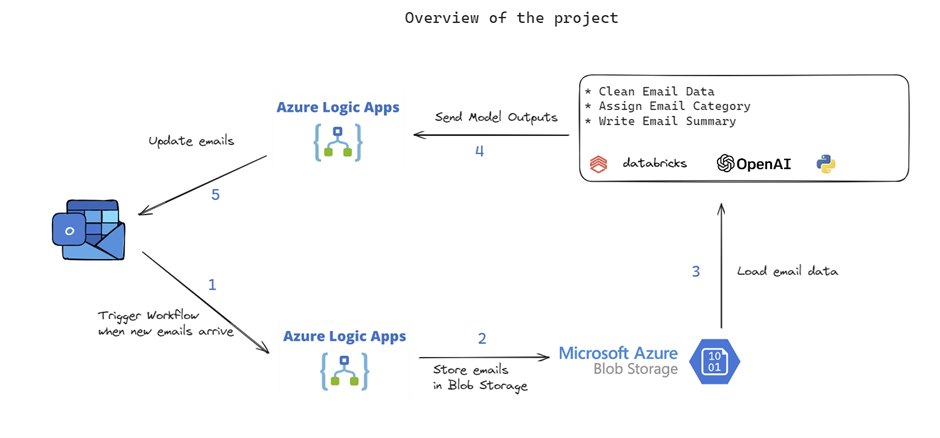Blog Authors:
Sagar Nikam
Alihan Zihna
Joanna Lenczuk
About UK Power Networks
UK Power Networks is the largest electricity distributor in the UK. It maintains electricity cables and lines in London, the South East and East of England, supplying energy to 19 million people.
Customer satisfaction is a critical success factor and UK Power Networks has won several awards for its contact centre and customer feedback strategy ensuring that all customers, and especially vulnerable customers, are protected.
The inhouse innovation team leverages its data assets and utilises machine learning to tackle net zero, automate internal processes and provide reliable, cost-effective solutions to customers. UK Power Networks is at the forefront of the energy transition, helping to enable the decentralisation of energy to a more sustainable, affordable and secure system. This includes supporting renewable energy, low-carbon heating and electric car chargers.
Overview of the challenge
Customers are increasingly using digital channels to get in touch and the customer service team at UK Power Networks receives an increasing number of emails each day (300-400 emails with a 10% increase year on year). Those emails can be classified into three categories. The first category includes requests for actions (jobs), such as preparing quotations or disconnecting clients. The second category includes questions on existing jobs or other inquiries about the business. The final category consists of emails of lower priority to the energy distributor, such as automatic replies or meeting notifications. The customer service team used to manually review incoming emails and assign categories to them, indicating their urgency. This process was time-consuming and prone to error, which could lead to delays for some customers or difficulties fulfilling service level agreements (SLAs).
The innovative solution
UK Power Networks partnered with CKDelta, Microsoft and Databricks to create a customer virtual agent, an automatic solution to speed up the email response process. It’s a new Outlook inbox experience, enhanced by intelligent features such as email classification and summarisation, using large language models (LLMs) on Azure Databricks. The solution was developed as a proof of concept to test the capabilities of generative AI for a customer service use case.
The customer virtual agent saves time that the customer service team can use to provide more customised support. Automatic categorisation of emails increases efficiency and minimises the risk of failing to meet SLAs. Summaries are particularly useful in condensing long chains of emails between customers and UK Power Networks’ departments. Reading a summary can give subject matter experts (SMEs) insight about the nature and urgency of the request, as well as a list of actions already taken by UK Power Networks. This is up to 10 times faster than reading a long chain of emails. The outputs provided by LLMs improve business processes in UK Power Networks and directly impact customer satisfaction.
Developing the solution with CKDelta
CKDelta has partnered with UK Power Networks to deliver several technical innovation projects. As part of the CK Hutchison Holdings Group, CKDelta utilises expertise and experience from industrial-scale sources to build intelligent applications using AI and machine learning models. CKDelta’s △Demand, △Power and △Priority intelligent apps have been used in UK Power Networks’ Envision, Optimise Prime and Spotlight projects respectively.
CKDelta is a Microsoft AI Partner and the customer virtual agent email processing workflow runs on the Azure Logic Apps platform. Each incoming email triggers this workflow. In the first step, it saves the body of an email, subjects and attachments in Azure Blob Storage. Then it moves to the computational part of the solution. This takes place in the Databricks platform.
Databricks allows using PySpark for data preprocessing easily and efficiently. PySpark was an essential tool in transforming UK Power Networks’ email dataset. It consists of large volumes of text data which is easy to load into PySpark DataFrames. They can then be viewed, explored, and interacted within Databricks’ notebooks. The email data was cleaned with the help of LLMs. The UK Power Networks’ instance of the GPT-3.5 Turbo model was accessed directly from Databricks using Azure OpenAI API. The model was used to identify parts of the emails requiring response from the customer service team. The instructions, containing UK Power Networks’ inside knowledge, are a part of the prompt passed to the model. LLMs are also being used to assign email categories and provide summaries of the messages.

Three GPT-3.5 Turbo models are responsible for handling incoming emails. Each of the models has exactly one task to perform; identify important parts of the emails, assign categories or summarise the content. Prompts passed to the models include domain knowledge that the customer service team at UK Power Networks uses to make decisions about incoming requests. Prompts can be updated quickly allowing the team to pivot in accordance with business needs. MLFlow experiments were used to test what prompts have the best impact on the model’s performance. Experiment tracking in Databricks is highly effective and with new LLMOps features introduced in MLFlow 2.4., it’s easy to compare prompts and track LLM-specific metrics. Registering LLMs, and accessing them for new incoming emails, is a quick process which enables agility in responding to customers.
In the last step, the predicted email categories and summaries are sent back to Outlook. A category is added to the original email as an email tag. Members of the customer service team can see the focus of email, before reviewing content, and easily identify communications that should be prioritised.
An email summary is then added in a different colour at the beginning of the original email. This makes the division between the original content and the LLM output clear and intuitive. Most importantly, the solution enhances the experience of the customer service team, without changing the way they proceed. It doesn’t require any additional work on their behalf or modify the approach that has proven to be optimal for them.
Next steps for the customer virtual agent
The solution has proven that LLMs can be successfully used to optimise business processes connected to customer service. The SMEs found the solution effective and time saving, highlighting the reliability of outputs provided by LLMs. It will have a significant impact on the focus of their work, which will no longer require manual classification of incoming emails. The next step will involve a wider implementation of the customer virtual agent. Over time it be customised further, addressing ongoing feedback from the customer service team. Using Databricks Model Serving, CKDelta will be able to test different model families, including Llama and Mistral models, to compare results with the current GPT-3.5 Turbo model. Model Serving provides a unified interface that enables managing multiple models with a single API, making future experimentation with varied LLMs very accessible. Those models could also be tested for other potential features, such as alerts related to the urgency of requests or provision of draft responses.
Visit the CKDelta △Discovery page to begin your AI and data innovation journey.














